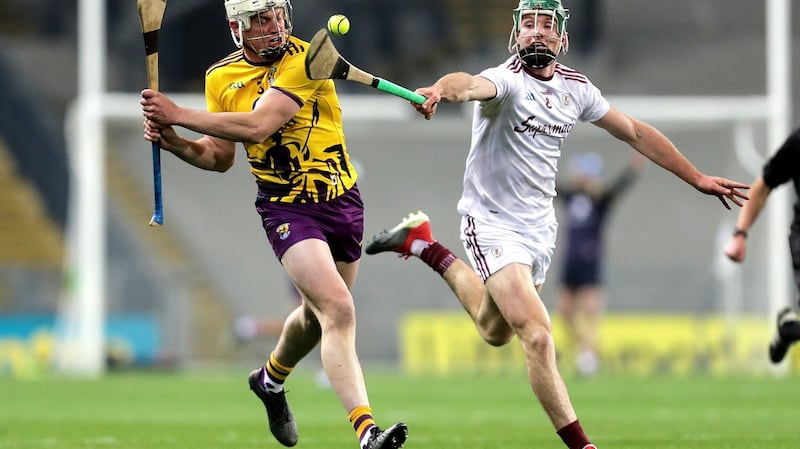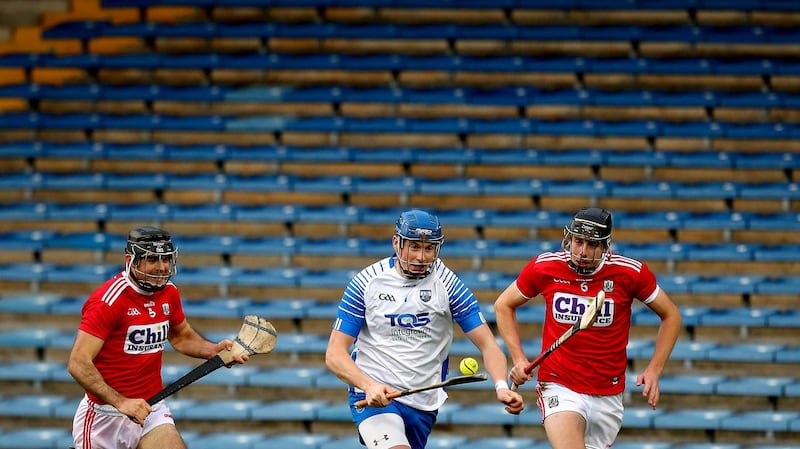Quiz time. Winner gets two All-Ireland final tickets. What would you think is the most common phrase used by GAA managers in pre-match and post-match interviews? You’ll hear some mix of the following any time you listen out:
“Need/had a bit of luck”.
“Raised our game”.
“Flat”.
“Energy levels”.
“No excuses”.
“Trained well”.
You’ve heard them all a million times. But I’d bet good money that you haven’t heard them as much as “work-rate”. It must be the winner by a country mile.
(Just in case you’re wondering, I have no All-Ireland tickets to give away. Nobody has, obviously. Maybe next year.)
I remember before the All-Ireland final in 2016, Tipperary manager Mick Ryan gave an interview where he mentioned “work-rate” or “hard work” eight times. Eight times in one interview! Media duties in the run-up to All-Ireland finals are never designed to give much away but Mick had no problem laying down the marker as to what he expected from his team on the day. And even though he was saying something completely obvious, it didn’t make it any easier for us to play against come the day. No wonder they won.
To my mind, work-rate is the most essential ingredient in bringing a high-level performance to any game. But even though we hear it mentioned all the time, it’s rare that a manager or a coach will put out into the public what they actually mean by it. You can use work-rate as a kind of handy phrase to throw around - nobody is going to argue with you if you say your team needs to work harder. But breaking down what it actually means is a bit trickier.
Last Sunday, Liam Sheedy was talking in his pre-match interview about Tipperary’s preparation. “We’re training away, the data is telling us we’re training well but you don’t really know until you get to the hop and thrust of championship.” My ears pricked up immediately because I don’t remember ever hearing a manager reference data before a game.
Misleading
The stats teams in every set-up will come with a raft of numbers to guide players and coaches. Some of them can be misleading, it has to be said. I’ve never been overly convinced by distance-covered as a meaningful stat because it doesn’t tell you much about what effect a lad’s running has had on the game. Anybody can run – but did he get involved? Or was he chasing his man around the place and not getting a touch of the ball?
A more relevant set of data when it comes to work-rate is hooks-blocks-tackles. There has been plenty of analysis to show that if you win this stat, you generally win your game. I’m sure teams get a run-down at half-time and where they’re at with those numbers. I know some managers use them when deciding what substitutions to make.
The beauty of the hook-block-tackle stat is that you can’t fudge it. There’s no grey area. A hook is a hook, a block is a block, a tackle is a tackle. None of them happen by accident or because you were lucky to be in the right place at the right time. They reflect the effort you put in.
The best explanation of work-rate I ever heard was from the Munster hooker Jerry Flannery. He was talking about work-rate one time and he described it as, “the effort after the effort.” How strong is your sustained effort after your first effort? Does your effort go from 100 per cent on the first to 70 per cent on the second? And then to 30 per cent on the third and so on down? Or does it stay at 100 per cent, even though fatigue has set in and every tackle and every bit of work sucks energy from you? Your work-rate is how close to 100 per cent you get to with the efforts after the first effort.
Go back through the performances over the first two weekends of the championship. Think of the teams that stick out in your mind where it was noticeable that lots of players were keeping up their effort after the first effort. It narrows down the field of contenders pretty quickly. Limerick achieved it, Galway achieved it – anyone who wants to live with them in this championship has to match it from here on out.
Tipperary’s training data probably showed Sheedy that the panel were in a good place to perform against Limerick but when the ball was thrown in it was John Kiely’s side who were consistently maintaining the effort after the first effort. In horrendous conditions, that’s always going to make a huge difference.
All teams are searching for the fundamental thing that comes first, that animalistic work-rate. Everybody is well able to hurl at this level – just look at the scores everybody is putting up. But the teams that will survive the longest are the ones who work hardest, who hook, block and tackle until the cows come home.
It is a beautiful thing to see when a small pack of hungry hurlers hunt down a single opposition player like snarling hungry wolves. We used to use this in games with Kilkenny, hunt down the prey in small groups, isolate a victim and pounce. Turn the ball over and move like lighting, like young lads after robbing an orchard and running for your life from a farmer.
Turnover ball
Galway did this numerous times on Saturday night. It was as if the eerie Halloween moon hanging over Croke Park brought out the Wolverine in Conor Whelan. Biceps bulging, fire in his eyes, blood boiling in his skin as he hunted down anything that came in his way. Every firework that erupted in the Dublin sky seemed like a calling for him to bundle over some Wexford prey and win turnover ball. His shooting was excellent, obviously, and he was unlucky to have his goal called back. But his work-rate was savage too.
And he was far from alone in this. Cathal Mannion chased 60 yards to hunt down Paudie Foley in second half. Foley led a good charge out of the Wexford defence and had moved himself into a good position to shoot, on the Galway 45 yards. Mannion tracked him the whole way and got in a hook. The ball went to ground, Galway hunted Wexford out to the sideline and Paul Morris had to try a very difficult shot over his shoulder from under the Cusack Stand that went wide.

This was just after half-time. Lee Chin had already scored the first point of the second half 30 seconds earlier to bring the margin down to five. If Mannion does not make that run or if he makes a token run with 70 per cent effort, he doesn’t get close enough to get the hook. Foley would have had a handy shot and the margin would have been down to four.
Two points in 30 seconds would have meant a bit of momentum for Wexford. As it was, Galway won possession from the puck-out and a loose Wexford slap brought a free and Joe Canning put them six ahead again. It was comfortable from then on and it started with Mannion making a 60-yard run to chase down someone who wasn’t even his marker.
On Sunday, Limerick were six-points clear in the 65th minute when they turned Tipperary over in their own half. What was interesting to me was the intensity with which Limerick players still hunted Tipp players down and their reaction to celebrating the turnover. Three Limerick players formed the pack - Gearóid Hegarty, Kyle Hayes and Will O’Donoghue. David Reidy was close enough to strike as well had he been required.
They celebrated with fist pumps and chest bumps as if they had just scored a crucial score. To them this was a crucial score. It looks like they hold turnovers and scores with the same value and work-rate is the currency.
It reminded me a bit of rugby, when there is a turnover of possession at a breakdown and the rest of the team runs in to congratulate the guy who has won the ball. Slaps on the backs, high fives, fist pumps, animated roars and in your face front-ups. These are big moments in rugby, real momentum-shifters.
Hurling can carry that kind of effect at key times in games, particularly in key areas of the pitch. A turnover that comes from a huge work-rate or a free that your team wins after three or four players hunt down the opposition and force them into overcarrying – that’s the sort of thing that teams take massive pleasure from.
And it’s important that they show it. The reaction of players around the turnover can be just as key as the turnover itself. It makes the other team think, “Jesus these lads are up for this, today is not our day, they’re all over us.”
Glaringly absent
Even with all the data and stats, work-rate can still be a little difficult to define. Partly, you know it when you see it. The flipside is, you definitely know it when you don’t see it. The kind of work-rate and hard work that we saw from Galway and Limerick over the weekend was glaringly absent from what Cork brought to Thurles.
Are we that surprised, in all honesty? Cork seem to turn in at least one of those displays in every championship. A game where they are outworked and outfought, where their effort after the first effort makes them look like they’re not overly pushed about whether they win or lose.

We know they’re terrific hurlers when it suits them. But we also know that they lack that kind of crazed obsession and aggression to get the ball back by any means necessary. Waterford had it Saturday and it made all the difference. We saw Aussie Gleeson putting in tackles in his newly-formed wrecking machine of a body. We saw Liam Cahill hunting up and down the line as if he was hurling himself. Waterford brought the work-rate the day demanded.
Cork didn’t. Yet again. They need to find it and fast and they need to find lads to implement it. Being a nice skilful hurlers doesn’t mean you can’t be a dog of a worker as well. Cathal Mannion is a nice skilful hurler, so is Conor Whelan. Gleeson, Hayes, TJ Reid – all lovely hurlers but they can be wrecking balls when they decide to do it. Cork will not go deep into a winter championship on a diet of flair alone.
Nobody will.










